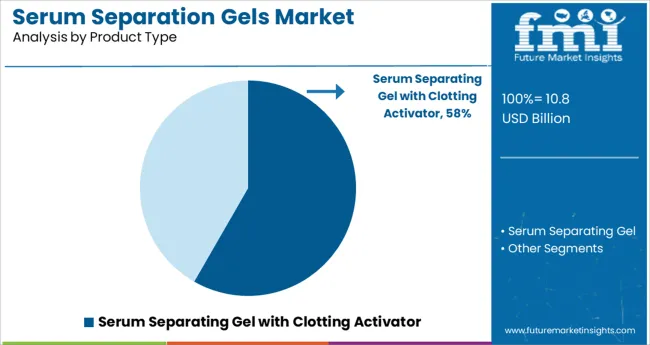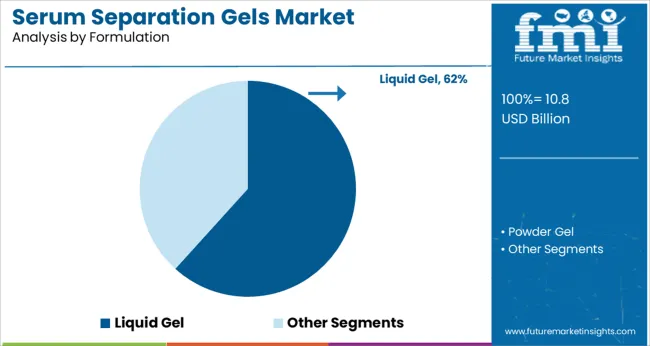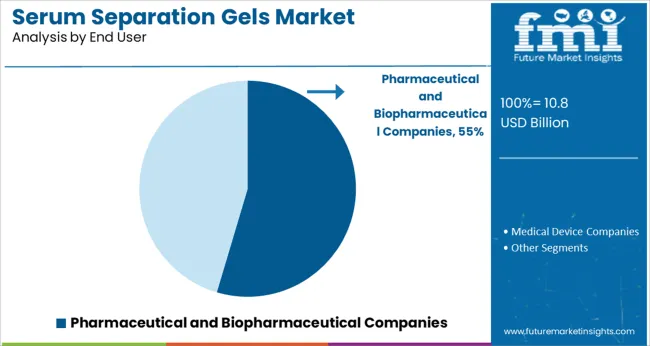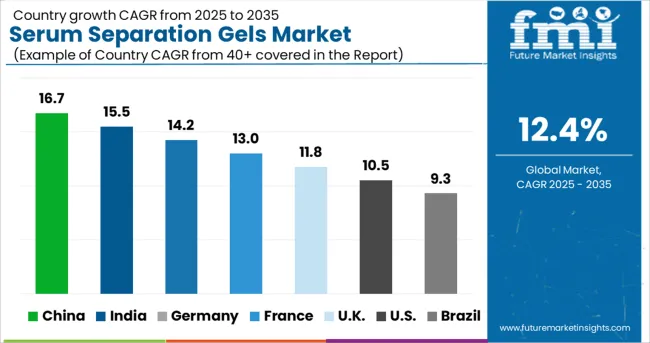The Serum Separation Gels Market is estimated to be valued at USD 10.8 billion in 2025 and is projected to reach USD 34.7 billion by 2035, registering a compound annual growth rate (CAGR) of 12.4% over the forecast period.

The serum separation gels market is experiencing steady growth, driven by increasing demand for reliable blood sample processing in clinical diagnostics and pharmaceutical research. Improvements in sample preparation techniques have emphasized the importance of efficient serum separation for accurate testing results. The rising prevalence of chronic diseases and the expansion of biopharmaceutical research have boosted the need for high-quality separation products.
Additionally, the increasing adoption of automated laboratory systems has increased demand for standardized and easy-to-use serum separation gels. Regulatory focus on sample integrity and testing accuracy has further promoted the use of advanced gel formulations.
Market growth is expected to be supported by continued innovation in gel chemistry and compatibility with a wide range of diagnostic assays. Segment growth is likely to be led by serum separating gels with clotting activators, liquid gel formulations, and pharmaceutical and biopharmaceutical companies as the primary end users.
The market is segmented by Product Type, Formulation, and End User and region. By Product Type, the market is divided into Serum Separating Gel with Clotting Activator and Serum Separating Gel. In terms of Formulation, the market is classified into Liquid Gel and Powder Gel.
Based on End User, the market is segmented into Pharmaceutical and Biopharmaceutical Companies and Medical Device Companies. Regionally, the market is classified into North America, Latin America, Western Europe, Eastern Europe, Balkan & Baltic Countries, Russia & Belarus, Central Asia, East Asia, South Asia & Pacific, and the Middle East & Africa.

The serum separating gel with clotting activator segment is projected to hold 58.3% of the market revenue in 2025, maintaining its dominance as the leading product type. This segment has grown due to its ability to expedite clot formation and improve the efficiency of serum separation from whole blood samples. Its widespread adoption is supported by laboratories seeking faster turnaround times without compromising sample quality.
The gel ensures effective separation and reduces the risk of contamination or hemolysis during sample handling. Its compatibility with a variety of blood collection tubes has further expanded its application across clinical and research settings.
The segment’s growth is driven by the increasing need for reliable pre-analytical solutions in diagnostic workflows.

The liquid gel formulation segment is expected to contribute 61.7% of the serum separation gels market revenue in 2025, establishing itself as the preferred formulation type. Liquid gels have gained popularity due to their uniform distribution in collection tubes and consistent performance in serum separation. This formulation improves the clarity of separated serum and facilitates better sample recovery for downstream analysis.
Laboratories have favored liquid gels for their stability and compatibility with automated analyzers. The ease of integration into existing sample processing workflows has accelerated adoption.
As diagnostic laboratories aim for improved accuracy and efficiency, the liquid gel formulation segment is expected to sustain its leading position.

Pharmaceutical and biopharmaceutical companies are projected to account for 54.6% of the serum separation gels market revenue in 2025, holding the largest share among end users. The growth in this segment is driven by the extensive use of serum separation gels in drug discovery, clinical trials, and quality control processes. These companies require reliable and standardized sample preparation methods to ensure consistency in bioanalytical testing.
The increasing focus on biologics development and personalized medicine has amplified the demand for high-quality separation products. Moreover, regulatory standards in pharmaceutical research emphasize stringent sample handling protocols, reinforcing the use of serum separation gels.
The segment is expected to maintain its market leadership as the biopharmaceutical sector continues to expand globally.
The demand for serum separation gels is predicted to grow due to an increase in the number of blood tests performed. The serum separation gels market is predicted to rise due to an increase in the number of blood banks testing for blood type and condition.
Furthermore, the sales of serum separation gels is predicted to increase as the number of clinical research studies in pathological science increases. The demand for serum separation gels may be boosted by an increase in the number of contract research businesses in the biotechnology area and increased investment in the serology field.
The high cost of serum separation gels may affect the sales of serum separation gels in some locations. The production of serum separation gels necessitates aseptic conditions, and the serum separation gels market share is predicted to grow as the number of manufacturing plants in emerging nations increases. These factors are forecasted to open up new opportunities in the serum separation gels market.

North America is predicted to witness high sales of serum separation gels during the forecast period. The increased demand for serum separation gels methods in North America is likely due to technological advancements in pathological examinations.
Due to the obvious increased expenditure in haematology and cancer research and development, Europe will be the second most dominant area for serum separation gels market growth.
As there are fewer clinical research businesses in Latin America, the sales of serum separation gels will rise at a slower pace. Following Europe, the Asia Pacific area is expected to see increased demand for serum separation gels as a result of the increased number of biotech enterprises in this region.
In addition, the favourable rise in the sales of serum separation gels is due to the increasing rate of blood cell preservation in animals in this region. China and India are predicted to be the most revenue-generating countries in the global separation gels market.

Qiagen N.V., Cardinal Health Inc., Medtronic PLC, Bio-Rad Laboratories, Microfluidics International Corporation, BioVision, Inc., Danaher Corporation, Becton Dickinson & Company, F. Hoffmann-La Roche Ltd., Merck KGaA, and others are some of the key players identified across the value chain in the serum separation gels market.
Key Developments in the Serum Separation Gels Market
| Report Attribute | Details |
|---|---|
| Growth rate | CAGR of 5% from 2025 to 2035 |
| Base year for estimation | 2024 |
| Historical data | 2014 to 2020 |
| Forecast period | 2025 to 2035 |
| Quantitative units | Revenue in million and CAGR from 2025 to 2035 |
| Report coverage | Revenue forecast, volume forecast, company ranking, competitive landscape, growth factors, and trends, Pricing Analysis |
| Segments covered | Product type, end user, region |
| Regional scope | North America; Western Europe, Eastern Europe, Middle East, Africa, ASEAN, South Asia, Rest of Asia, Australia and New Zealand |
| Country scope | USA.; Canada; Mexico; Germany; UK.; France; Italy; Spain; Russia; Belgium; Poland; Czech Republic; China; India; Japan; Australia; Brazil; Argentina; Colombia; Saudi Arabia; UAE; Iran; South Africa |
| Key companies profiled | Qiagen N.V., Cardinal Health Inc., Medtronic PLC, Bio-Rad Laboratories, Microfluidics International Corporation, BioVision, Inc., Danaher Corporation, Becton Dickinson & Company, F. Hoffmann-La Roche Ltd., Merck KGaA Gobain; ?i?ecam Group; Vitro |
| Customization scope | Free report customization (equivalent to up to 8 analysts working days) with purchase. Addition or alteration to country, regional & segment scope. |
| Pricing and purchase options | Avail customized purchase options to meet your exact research needs. |
The global serum separation gels market is estimated to be valued at USD 10.8 billion in 2025.
It is projected to reach USD 34.7 billion by 2035.
The market is expected to grow at a 12.4% CAGR between 2025 and 2035.
The key product types are serum separating gel with clotting activator and serum separating gel.
liquid gel segment is expected to dominate with a 61.7% industry share in 2025.






Full Research Suite comprises of:
Market outlook & trends analysis
Interviews & case studies
Strategic recommendations
Vendor profiles & capabilities analysis
5-year forecasts
8 regions and 60+ country-level data splits
Market segment data splits
12 months of continuous data updates
DELIVERED AS:
PDF EXCEL ONLINE
Serum Vials Market Size and Share Forecast Outlook 2025 to 2035
Serum Bottles Market Size and Share Forecast Outlook 2025 to 2035
Serum Lactate Testing Market Analysis - Size, Share, and Forecast 2025 to 2035
Market Positioning & Share in the Serum Bottles Market
Serum Separating Tubes Market
Hair Serum Market Size and Share Forecast Outlook 2025 to 2035
Hair Serums Ingredient Market Size and Share Forecast Outlook 2025 to 2035
Cryo Serums Market Size and Share Forecast Outlook 2025 to 2035
Global Solid Serum Market Size and Share Forecast Outlook 2025 to 2035
Facial Serum Market Forecast and Outlook 2025 to 2035
Vitamin C Serums (Ascorbic Acid) Market Analysis - Size and Share Forecast Outlook 2025 to 2035
Global Probiotic Serum Market Size and Share Forecast Outlook 2025 to 2035
Anti-Acne Serum Market Report - Demand & Growth Forecast 2025 to 2035
Crimp Neck Serum Bottles Market Size and Share Forecast Outlook 2025 to 2035
Anti-Aging Serums Market Analysis by Type, Application and Region from 2025 to 2035
Niacinamide Serums Market Size and Share Forecast Outlook 2025 to 2035
Hair Growth Serums Market Analysis - Size and Share Forecast Outlook 2025 to 2035
Oil Free Eye Serum Market Analysis – Growth & Demand 2024-2034
Hair Thickener Serum Market Insights – Growth & Demand 2025 to 2035
Fragrance-free Serum Market Report – Growth & Trends 2024-2034

Thank you!
You will receive an email from our Business Development Manager. Please be sure to check your SPAM/JUNK folder too.
Chat With
MaRIA